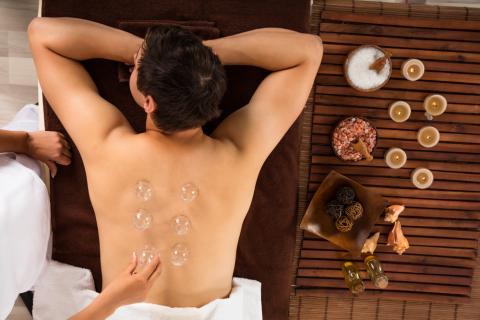
Cupping, as defined by the National Center for Complementary and Integrative Health, is “a traditional Chinese medicine practice that involves placing cups on the skin to create suction.” Suction cups are left on the skin to draw fluid into the area, thereby speeding the healing process. Cupping follows the Chinese philosophy: “Where there’s stagnation, there will be pain. Remove the stagnation, and you remove the pain,” as Pacific College of Oriental Medicine explains.
What are the benefits of cupping?
Cupping can improve pain, especially in the back and neck, by creating blood flow to the affected area. Additionally, the Harvard Medical School acknowledges cupping’s ability to help in managing migraines and knee arthritis, improving immune function, and even aiding in skin issues like hives or acne. Additionally, the Journal of Traditional and Complementary Medicine published a report in 2015 suggesting that cupping may also be an effective treatment for facial paralysis and cervical spondylosis.
Cupping can also treat fascia (our body’s glue). As an affected area is suctioned, thickened fascia is stretched, resulting in increased mobility.
Additional benefits of cupping may include:
- Improved relaxation
- Improved circulation
- Reduced inflammation
- Clearing of congestion or improved asthma
- Reduced fatigue
- Reduced anxiety
What does the data show?
A 2018 report from the Journal of Acupuncture and Meridian Studies concluded that there is growing evidence of its potential benefits in the treatment of some diseases—namely, promoting “peripheral blood circulation, and improving immunity.” A 2012 review found that cupping has potential effect for herpes zoster and other specific conditions while a 2016 study found that cupping had significant relief upon those with chronic neck and shoulder pain.
How does cupping work?
Cupping is often done in conjunction with massage or acupuncture, though not always. In most cases, a person lays on his or her stomach while the therapist places cups on affected areas. These cups act as a suction, pulling blood into the area. As fresh blood works its way into the affected tissue, stagnated blood is sucked out by the suction cup. The result is a large discolored circle, often starting as red and working to blue or even black; in many cases, the result looks like a large hickey. Similar to bruising, the discoloration will fade after a few days.
It’s important to note that there are several varieties of cupping. Many people are familiar with fixed cupping, in which the cup is applied to one area for a given amount of time, but gliding (or moving) cupping—in which a massage oil is placed on the skin to let the cups be moved around easily—is also popular.
Where can I find a cupping practitioner?
Many acupuncture practitioners or massage therapists also perform cupping, but finding a referral is often your best option. Many health centers and sports institutes may have a cupping practitioner on hand. Always receive cupping from a registered practitioner.








